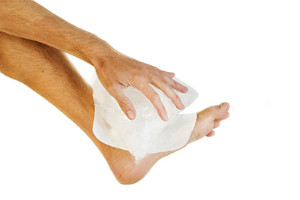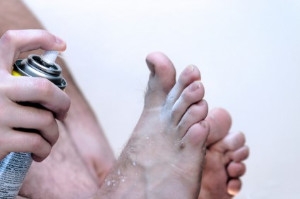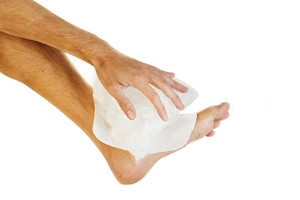Blog

Swollen Feet and Pregnancy
 As pregnancy progresses, the body’s natural response is to produce additional fluids that accommodates the needs of the growing fetus. Most women experience swollen feet as a result of this, which can be uncomfortable. Research has indicated this accounts for approximately twenty-five percent of the weight that is gained during pregnancy. There are additional reasons why the feet become swollen. These include standing for extended periods of time, drinking large amounts of caffeine, or eating foods that are high in sodium content. There are methods that can be implemented to help reduce possible swelling. These consist of elevating your feet frequently throughout the day, wearing shoes that are comfortable, and spending limited time outside in the warmer weather. If you would like additional information about how pregnancy affects the feet, it is suggested to speak to a podiatrist who can answer any questions you may have.
As pregnancy progresses, the body’s natural response is to produce additional fluids that accommodates the needs of the growing fetus. Most women experience swollen feet as a result of this, which can be uncomfortable. Research has indicated this accounts for approximately twenty-five percent of the weight that is gained during pregnancy. There are additional reasons why the feet become swollen. These include standing for extended periods of time, drinking large amounts of caffeine, or eating foods that are high in sodium content. There are methods that can be implemented to help reduce possible swelling. These consist of elevating your feet frequently throughout the day, wearing shoes that are comfortable, and spending limited time outside in the warmer weather. If you would like additional information about how pregnancy affects the feet, it is suggested to speak to a podiatrist who can answer any questions you may have.
Pregnant women with swollen feet can be treated with a variety of different methods that are readily available. For more information about other cures for swollen feet during pregnancy, consult with one of our doctors from Kitsap Foot & Ankle Clinic. Our doctors will attend to all of your foot and ankle needs.
What Foot Problems Can Arise During Pregnancy?
One problem that can occur is overpronation, which occurs when the arch of the foot flattens and tends to roll inward. This can cause pain and discomfort in your heels while you’re walking or even just standing up, trying to support your baby.
Another problem is edema, or swelling in the extremities. This often affects the feet during pregnancy but tends to occur in the later stages.
How Can I Keep My Feet Healthy During Pregnancy?
- Wearing orthotics can provide extra support for the feet and help distribute weight evenly
- Minimize the amount of time spent walking barefoot
- Wear shoes with good arch support
- Wear shoes that allow for good circulation to the feet
- Elevate feet if you experience swelling
- Massage your feet
- Get regular, light exercise, such as walking, to promote blood circulation to the feet
If you have any questions please feel free to contact one of our offices located in Bremerton and Port Orchard, WA . We offer the newest diagnostic and treatment technologies for all your foot and ankle needs.
Pregnancy and Foot Health
Many pregnant women complain about foot pain while they are expecting. Foot pain can primarily be caused by weight gain and hormonal changes taking place in the body. By understanding how pregnancy impacts the health of a woman's feet, a pregnant woman can take action to keep her feet as healthy and comfortable as possible.
Because a woman's weight changes during pregnancy, more pressure is brought to bear on both the legs and the feet. This weight shift can cause two major foot problems: over-pronation, also known as flat feet, as well as edema, which is swelling of the feet. Over-pronation occurs when the arch of the foot flattens, causing the foot to roll inwards when the individual is walking, and can aggravate the plantar fascia tissues located along the bottom of the feet. If these tissues become inflamed, a pregnant woman can experience pain in the heel of the foot as well as severe foot pain while walking or standing. Swelling of the feet, or edema, often occurs in the later stages of pregnancy. It is caused by slow circulation and water retention, and may turn the feet a light purple color.
To keep feet in good health and prevent over-pronation, pregnant women should avoid walking barefoot and be sure they are wearing shoes that offer good arch support. A device known as an orthotic can be added to regular footwear in order to provide additional support for the feet during pregnancy. Any expectant mother whose feet hurt should first check to see if the shoes she is wearing are old, worn out and not offering the proper support necessary for distributing the weight of her body during pregnancy.
To treat edema of the feet, a good start is to wear quality footwear which offers support and good circulation. Keep feet elevated whenever possible by using a foot stool while seated. Stay well hydrated by drinking plenty of water to prevent water retention in the feet. Any swelling that occurs in only one foot should be examined as soon as possible by a doctor.
Good foot health during pregnancy can help expectant mothers avoid foot pain that leads to other health problems. Massaging the feet and doing regular gentle exercise like walking aids foot health by contributing to good circulation. Supportive shoes are also a good investment that will support foot health during pregnancy.
What Are the Symptoms of Athlete’s Foot?
 If you notice an uncomfortable rash on your foot, you may have a condition that is known as athlete’s foot. Symptoms of this ailment include a burning sensation between the toes or on the soles of the feet, in addition to dry and flaky skin. In severe cases, blisters can form. It is known to be contagious, and it is important to take precautions, which can help to prevent this condition. These include wearing appropriate shoes while in public pools, shower room floors, and surrounding areas. Additionally, it is helpful to alternate shoes that are frequently worn, and ensuring clean tools are used while pedicures are performed. It is beneficial to wear cotton socks, which is advantageous in absorbing any moisture the feet produces. If you notice you have this condition, it is suggested that you speak to a podiatrist who can offer proper treatment options.
If you notice an uncomfortable rash on your foot, you may have a condition that is known as athlete’s foot. Symptoms of this ailment include a burning sensation between the toes or on the soles of the feet, in addition to dry and flaky skin. In severe cases, blisters can form. It is known to be contagious, and it is important to take precautions, which can help to prevent this condition. These include wearing appropriate shoes while in public pools, shower room floors, and surrounding areas. Additionally, it is helpful to alternate shoes that are frequently worn, and ensuring clean tools are used while pedicures are performed. It is beneficial to wear cotton socks, which is advantageous in absorbing any moisture the feet produces. If you notice you have this condition, it is suggested that you speak to a podiatrist who can offer proper treatment options.
Athlete’s foot is an inconvenient condition that can be easily reduced with the proper treatment. If you have any concerns about your feet and ankles, contact one of our doctors from Kitsap Foot & Ankle Clinic. Our doctors will treat your foot and ankle needs.
Athlete’s Foot: The Sole Story
Athlete's foot, also known as tinea pedis, can be an extremely contagious foot infection. It is commonly contracted in public changing areas and bathrooms, dormitory style living quarters, around locker rooms and public swimming pools, or anywhere your feet often come into contact with other people.
Solutions to Combat Athlete’s Foot
- Hydrate your feet by using lotion
- Exfoliate
- Buff off nails
- Use of anti-fungal products
- Examine your feet and visit your doctor if any suspicious blisters or cuts develop
Athlete’s foot can cause many irritating symptoms such as dry and flaking skin, itching, and redness. Some more severe symptoms can include bleeding and cracked skin, intense itching and burning, and even pain when walking. In the worst cases, Athlete’s foot can cause blistering as well. Speak to your podiatrist for a better understanding of the different causes of Athlete’s foot, as well as help in determining which treatment options are best for you.
If you have any questions please feel free to contact one of our offices located in Bremerton and Port Orchard, WA . We offer the newest diagnostic and treatment technologies for all your foot and ankle needs.
Athlete’s Foot
Athlete’s foot, or tinea pedis, is a skin disease caused by a fungal infection. The infection typically occurs between the toes, and the feet are most subject to this disease because shoes best create the warm, dark, and moist environment in which fungus thrives. Other areas that create a similar environment, such as swimming pools, public showers, and locker rooms; can also promote fungi growth.
Symptoms of athlete’s foot include dry skin, itching, scaling, inflammation, and blistering. Sometimes, blisters can evolve into the cracks or breaks in the skin. The exposed tissue can then create pain, swelling, and discharge. The spread of infection can cause itching and burning as well.
While athlete’s foot commonly occurs between the toes, it may also spread to the toenails or soles of the feet. Other parts of the body, such as the groin or underarms, can also become infected if they are touched after the original area of infection is scratched. Aside from physical contact, athlete’s foot can also spread through the contamination of footwear, clothing or bedsheets.
Proper foot hygiene is essential in preventing athlete’s foot. You can prevent the fungus from spreading by frequently washing your feet using soap and water, thoroughly drying the feet between the toes, changing shoes and socks every day to reduce moisture, and ensuring that bathroom and shower floors are disinfected. Other tips include using shower shoes, avoiding walking barefoot in public environments, wearing light and airy shoes, and wearing socks that keep the feet dry.
While treatment for athlete’s foot can involve topical or oral antifungal drugs, mild cases of the infection can be treated by dusting foot powder in shoes and socks. Any treatment used can be supplemented by frequently bathing the feet and drying the toes. If proper foot hygiene and self-care do not ease your case of athlete’s foot, contact your podiatrist. He will determine if the underlying cause of your condition is truly a fungus. If that is the case, a comprehensive treatment plan may be suggested with the inclusion of prescription antifungal medications.
What Causes a Stress Fracture?
 Consistent overuse of the muscles in the foot often produces a condition that is known as a stress fracture. Repeated impact that comes from running or jumping activities can cause the muscles to lose shock absorption, and the result may be a small fracture in the bone. It is possible that stress fractures can be prevented when the feet are strong. This can be accomplished by incorporating a healthy diet into your lifestyle, wearing shoes that fit correctly, and gradually increasing the power of your workout. The symptoms that are associated with stress fractures include pain while walking or completing daily activities, tenderness if the foot is touched, or possible bruising. If you feel you have a stress fracture, it is suggested to consult with a podiatrist who can guide you toward proper treatment options.
Consistent overuse of the muscles in the foot often produces a condition that is known as a stress fracture. Repeated impact that comes from running or jumping activities can cause the muscles to lose shock absorption, and the result may be a small fracture in the bone. It is possible that stress fractures can be prevented when the feet are strong. This can be accomplished by incorporating a healthy diet into your lifestyle, wearing shoes that fit correctly, and gradually increasing the power of your workout. The symptoms that are associated with stress fractures include pain while walking or completing daily activities, tenderness if the foot is touched, or possible bruising. If you feel you have a stress fracture, it is suggested to consult with a podiatrist who can guide you toward proper treatment options.
Activities where too much pressure is put on the feet can cause stress fractures. To learn more, contact one of our doctors from Kitsap Foot & Ankle Clinic. Our doctors can provide the care you need to keep your pain free and on your feet.
Dealing with Stress Fractures of the Foot and Ankle
Stress fractures occur in the foot and ankle when muscles in these areas weaken from too much or too little use. The feet and ankles then lose support when walking or running from the impact of the ground. Since there is no protection, the bones receive the full impact of each step. Stress on the feet can cause cracks to form in the bones, thus creating stress fractures.
What Are Stress Fractures?
Stress fractures occur frequently in individuals whose daily activities cause great impact on the feet and ankles. Stress factors are most common among:
- Runners
- People affected with Osteoporosis
- Tennis or basketball players
- Gymnasts
- High impact workouts
Symptoms
Pain from the fractures occur in the area of the fractures and can be constant or intermittent. It will often cause sharp or dull pain with swelling and tenderness. Engaging in any kind of activity which involves high impact will aggravate pain.
If you have any questions please feel free to contact one of our offices located in Bremerton and Port Orchard, WA . We offer the newest diagnostic and treatment technologies for all your foot and ankle needs.
Dealing with Stress Fractures of the Foot and Ankle
Stress fractures are small breaks in the bone that are caused by repetitive stress. They typically occur due to overuse, forcing the bones of the foot or ankle to continually absorb the full impact of each step taken. Stress fractures can also be caused by abnormal foot structure, osteoporosis, bone deformities, or wearing improper footwear during exercise.
Stress fractures are common for individuals whose daily activities cause high levels of impact on their feet and ankles. Those who run, play tennis or basketball, or practice gymnastics tend to experience these fractures more frequently. Anyone is susceptible to this problem, though. Individuals who are normally sedentary and suddenly begin an intense, high impact workout may sustain stress fractures. This is because their muscles are not yet strong enough to handle and cushion the intensity of their activity. Osteoporosis may also cause someone to get stress fractures, because the disease weakens an afflicted person's bones and makes it easier for them to break down.
Pain from stress fractures typically occurs in the general area of the fracture. Pain can also manifest as “pinpoint pain” or pain that is felt when the site of the injury is touched, and can be accompanied by swelling. It may occur during or after activity, and it may disappear while resting and return when standing or moving. Engaging in any kind of activity, high impact or otherwise, will aggravate the pain. If the intensity of the activity increases before the stress fracture has properly healed, it can cause a full fracture.
Treatment can vary depending on the individual and the degree of injury. The primary way to treat a stress fracture is to rest the hurt foot. Some fractures will heal quickly with only a little bit of rest, while others may require a long rest period and the use of crutches, immobilization, or physical therapy. Under certain circumstances, surgery may be required to install support pins around the fracture to assist in healing.
If you are undergoing a new exercise regimen in running or some other kind of high impact activity, set incremental goals on a weekly basis so you can build up muscle strength. Make sure to wear supportive shoes to better protect you feet.
If you begin to experience any symptoms of stress fractures, you should stop exercising and rest. If the symptoms persist, consult with your podiatrist. Remembering these tips can help you prevent stress fractures to your foot and ankle, and allow you to continue living normally.



